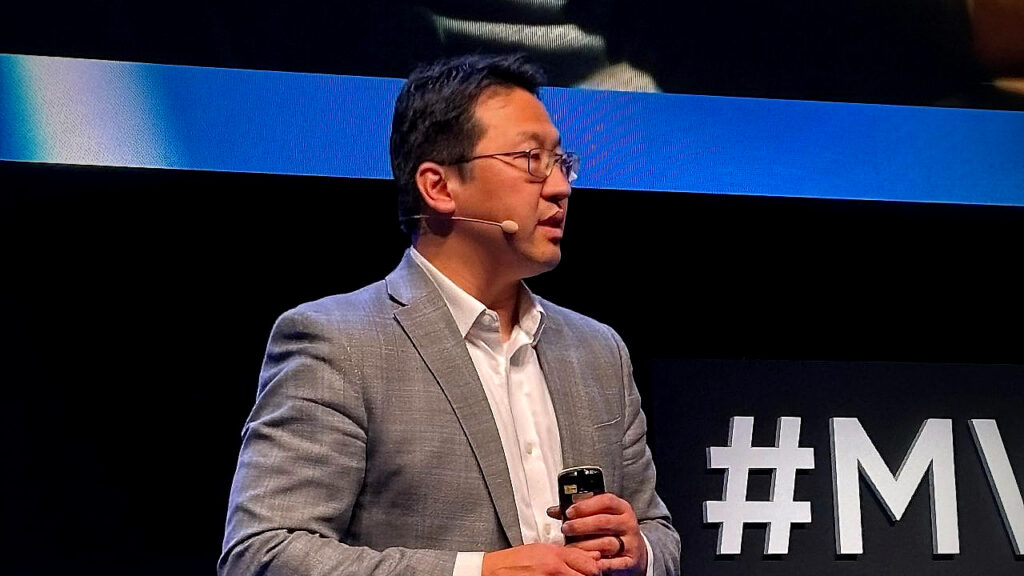This article, recounting an interview with Accenture’s ‘cloud-first’ commander Jefferson Wang at MWC at the end of last month, might be taken as a companion piece, of sorts, with last week’s replay of an MWC meeting with Jennifer Artley (see here and here), in charge of edge-5G stuff at Verizon Business. Artley told how the US-based carrier is setting about the global enterprise market with renewed purpose, in lock-step with an army of ‘ecosystem’ partners – adjacent or behind its closest global system integrators (GSIs). Artley never mentioned Accenture, but we all know it is in the mix.
And the meeting with Wang – 20 minutes on a cramped sofa in a busy lounge suite amid the comfortable consultancy living-rooms in hall three (little to show, lots to say) – took place directly after the discussion with Artley, and the day before the pair were to appear on stage together. A trick of the scheduling; but both are driving the private-5G agenda for their firms, and the conversation flowed at MWC almost exactly between the two. “Who’s the best?”, we ask Artley of the GSIs. “Do you have favourites?”, we ask Wang of the MNOs. Both laugh it off.
But Wang’s response was cute, too; brilliantly political, but perfectly revealing. “We’re agnostic, but we have a point of view. That’s very important. Our point of view is very strong. And you can follow our point of view, or you can disagree with it. We’re happy both ways.” In fact, he was responding to a question about network vendors, instead; but the meaning is the same: that Accenture will propose a solution for enterprises from the very best components, which it evaluates and knows – from the best spectrum, networks, computing, devices, software, and management services.

This solution will suit their purpose exactly, or as well as possible, the message goes; it is up to the enterprise, in the end, and their purchasing biases, whether they take the specified parts from the specified vendors. In other words: yes, Accenture has favourites, in every discipline, but they shift according to each customer case. And Accenture will not force the issue, beyond some kind words. The customer is king, the story invariably goes. Does that mean, then, that Accenture goes into every consultancy session almost blind, so far as its own vendor biases go?
“You can’t do that,” responds Wang. “Because then the speed-to-value doesn’t work. They’re in a competitive market and time counts. So we have to have a point of view.” Perhaps the question is phrased wrong; the upshot, perhaps, is that Accenture might approach the enterprise problem almost blind, all-ears and open-minded, but that it is quickly clear-sighted about the enterprise solution. “You focus on what’s best for the client. Everybody’s spectrum is very different. Just because an operator has spectrum does not mean it can serve every part of the market,” says Wang.
Spectrum appears to be a key motivation, still, to tap mobile operators in the design phase, even if the operator is represented in the deal by their enterprise division – supposedly liberated of such parochial assets to go after global business. Accenture has “built a tool”, says Wang, that “works through” the spectrum offerings from every operator in every geography. At the kind of multinational scale Accenture is interested in (“we serve 19 industries; we serve the [Forbes] Global 2000 [of the largest companies]”), the final solution is probably fragmented in terms of spectrum.
“The client usually has multiple locations,” says Wang. But the point of view, right, is that you know what is best for the customer – the best spectrum, the best radio, the best core network? That you will procure the best; which relies on your experience and knowledge in the game? Which is a personal thing, right? “Actually, no,” says Wang, responding to the last point, before clarifying the bigger one. “It’s not personal; because I could get hit by a truck tomorrow – so personal is not scalable. It’s about partnerships, and pre-integration – to get to speed-to-value.”
Which surely means, ‘yes’, effectively; that hands-on experience and hard-won knowledge, gained through the hype days of private 5G (et al), means Accenture can map an enterprise problem to a matrix (opinion) of the best mobile operators, network vendors, software developers, hardware makers, and so on and so forth – to devise the correct solution each time. The new information, then, is the corresponding schematic of partners, including the likes of Verizon Business, has also been mapped into a schedule of pre-integrations, so the componentry is quick to deploy.
Wang says: “We are building a practice, and building a business, where we have co-invested with ecosystem partners to pre-integrate to reach speed-to-value – that’s a very different situation. So we are agnostic [about the solution], but we have a point of view [about its components] – which means speed-to-value, based on the work we’ve done [with partners] to get here.” Okay; makes sense. He suggests – interestingly, a little confusingly – that the matrix-selection is easier to optimise in cost-constrained pilot projects, where scale-exercises bring new constraints.
“The client generally has a cost profile they’re trying to hit and a capability they’re trying to define. A lot of times, they might want a very low-cost pilot, and they’re okay if the blueprint doesn’t scale. In which case you have the opportunity to figure out the best solution for spectrum, radio, core, compute. But other clients are down the path, ready to scale this exact SKU to 1,000 locations. Which is a different discussion. Because they want us to build five other use cases on top. That’s a much different decision process,” he explains.
Has the 5G proposition become easier to make work with enterprises – because devices are available and costs are down, and the old telecoms industry has limbered-up? Has all of that shifted in the last 12 months? “For sure, it’s happening. The operators are more willing to work [in collaboration], not wanting to do it all themselves; they are more willing to partner. Devices – I mean, yes, but we still need more sensors, more cameras, more everything. But everybody knows what 5G is now; they’re more educated – latency for this, mobility for that, uplink for whatever else.”
Wang goes on: “So we’re getting this mad rush. But it still requires a few other things to come into place. Like business models – which is something we don’t talk about enough. Clients approach us all the time, to ask, ‘can you be the hand we shake?’ Because they don’t want multiple contacts and contracts, actually – it is an administrative burden, and an accountability gap. They want one-hand-to-shake – which brings the business outcome, via the partner ecosystem and the technology solution.”
So whose hand is it? “It depends on the client, and [who has] the existing relationship with them. If we have that relationship, they generally ask us to bring everyone together. There are other times where it’s a scaled opportunity and we’re not the incumbent – and we are asked [by others] to participate in the ecosystem. You need both models for the industry to grow.” It was the same message from Verizon Business, an hour before; but the sense is the big system integrators increasingly hold sway with big businesses.
Wang says: “We are probably working with them in some capacity. They turn to Accenture because they want to talk about transformation and reinvention, and they might talk to another part of the value chain when they want a specific piece of the tech. That’s the difference, right? If they want to talk about a transformation, and then a ‘run’ – or a run-transform-run – then they will generally go to a GSI.” And what about the role of mobile operators in all of this – when, in hard-nosed Industry 4.0 cases at least, data is to be retained on site, sprung in privately-licensed spectrum?
Have you even got an operator at the table, or invisible behind-the-scenes? Is there always an operator? “Well, here’s the thing, based on the use case you’re trying to solve…”. Okay, so what about if the table belongs to a big automotive manufacturer, which wants to ring-fence everything on-prem? “If they want a reliable network on-prem, and they want to do video, say, then you bring in an operator – because you want localised higher-band spectrum. But equally, there are opportunities just with mid-band coverage in certain countries with industrial spectrum.”
So in those situations, would you expect to have an operator in tow as well? Wang responds: “The thing is, we are generally talking with clients about more than one use case. Because one use case never drives the answer. We have this patented tool that drives out a value case, which covers multiple business cases – and for those you typically need a variety of spectrum. So, yes, we generally bring an operator in. Maybe the client thinks they can do it all with innovation-band spectrum. But generally, as the business case builds, they need licensed spectrum, as well.”
Which tells another story – not often heard, but getting louder; including at MWC this year – that nationally-available public 5G spectrum will be increasingly brought-to-bear on the enterprise market in the coming years, and that mobile operators, fronted by their global enterprise divisions, will increasingly show their teeth in the hybrid network-and-cloud game in Industry 4.0. “The private wireless market is starting to shape up and mature. Perspectives have changed. Before, everyone was positioned as competitors,” explains Wang.
“Whereas, in reality, we’re complimentary – in terms of capabilities. I mean Verizon, say, has incredible spectrum holdings in the low, mid, and high [bands]. It is really good at pre-certifying radios and devices onto its spectrum – which is a major part of the whole thing. We are good at making sure the client’s value proposition is clear, and we’re probably already engaged with them on digital reinvention in some form or other – so [it is natural for us to] crystalise where private wireless might be used, and how the ecosystem should come together at the edge.”

